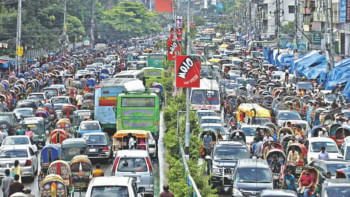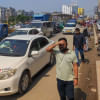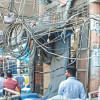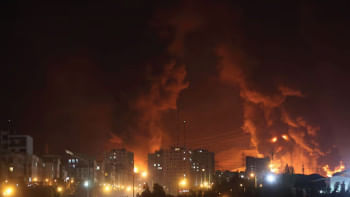Trapped in Dhaka’s traffic: How to overcome this crisis?

Every day, the roads of Dhaka city, become clogged with traffic, trapping citizens in seemingly endless jams. The city, home to over 20 million people in an approximate 300 square kilometer area, has become notorious for its stagnation, with average speed of vehicles falling to just 4.8 kilometers per hour. This means a journey that should take minutes can stretch into hours, with profound impacts on the economy, environment, and quality of life.
This deterioration has been hampering work life by shortening 82 lakh working hours per day. Again, the financial cost is staggering. According to the BUET-run Accident Research Institute (ARI), traffic congestion in Dhaka costs the economy an estimated $6.5 billion annually in lost productivity, fuel wastage, and health expenses leading to indirect downsizing the country's GDP by 6 to 10 percent annually. Commuters spend hours in traffic, wasting time that could otherwise be productive.
Traffic congestion is more than an inconvenience—it is a crisis that demands urgent action. Before delving into potential solutions, it is essential to grasp the causes and consequences of traffic problem in Dhaka. The city's rapid urbanisation has exacerbated the problem. Dhaka's roads were never designed to handle the sheer volume of vehicles now using them. As the population has grown and the upper-middle class expanded, the number of cars on the roads has skyrocketed. Compounding this is the fact that public transportation is inadequate, pushing many residents to rely on private vehicles, resulting in abysmal traffic conditions.
The environmental toll is equally alarming. Vehicles idling in traffic for hours release harmful emissions, contributing to Dhaka's already poor air quality. Additionally, the mental and physical health impacts are severe. Stress levels accelerated when people are trapped in cars and buses for long periods, and the rate of traffic accidents increases when frustrated drivers make rush decisions.
But how do we solve a problem so deeply entrenched in the city's structure? The solution, I believe, lies in a simple but effective idea: creating simple but effective overpasses or underpasses at every four-road intersection.
As these intersections become chaotic during peak hours as traffic converges from multiple directions, leading to long queues and delays, overpasses or underpasses at these key junctions could revolutionise traffic flow. An overpass allows vehicles traveling in one direction to pass over the intersection without stopping, while an underpass achieves the same effect by routing one direction of traffic below the intersection.
This system has been implemented successfully in cities around the world, where traffic congestion once paralleled Dhaka's current situation. I observed this alternative in Madrid, where the overpasses and underpasses served as a panacea to traffic congestion along with strong-active traffic signaling for nonstop transition of vehicles along the roads.
Likewise, its application is also found in developing countries such as Sri Lanka, India, China, Brazil, Mexico, Indonesia, where overpasses and underpasses have transformed how traffic moves through densely urban territory. By eliminating the need for vehicles to stop and start constantly, these cities have seen significant improvements in traffic flow.
Secondly, it might assist in saving time. Currently, traffic police spend hours on the road managing traffic congestion. This solution would help reduce the urgency of employing huge number of traffic police. Again, commuters, including students, could reach their destinations faster, improving productivity, and reducing the frustration of daily travel.
Furthermore, vehicles consume more fuel when constantly stopping and starting. An uninterrupted traffic flow means less fuel consumption, which would save travelers money and reduce carbon emissions. This would contribute to better air quality, improving the overall health of the city's residents.
Finally, traffic accidents are more likely to occur in congested areas, especially at busy intersections. By eliminating the vehicles' necessity to stop and navigate these intersections, the likelihood of accidents might decrease.
Of course, implementing overpasses and underpasses across the city would not be without challenges. The initial construction cost would be high, and the disruption caused during the building phase could exacerbate traffic in the short term. However, the long-term benefits far outweigh these initial difficulties. Careful planning is essential.
The government would need to prioritise the busiest intersections first and foremost. For example, Motijheel, Shahbagh, Farmgate, or Mirpur-10 intersections all demand well-structured underpass system. On the other hand, intersections in Nilkhet or Mirpur-1 require overpassing. These initiatives could be taken as pilot phase, and the subsequent actions can follow its success.
While overpasses and underpasses can significantly alleviate traffic congestion, they should be part of a broader, more comprehensive traffic management strategy. Improving public transportation similar to the newly introduced Dhaka metro rail is vital to reducing the number of private vehicles on the road. Ride-sharing initiatives should be encouraged, and traffic laws must be enforced more strictly to prevent illegal parking and lane violations.
Dhaka must prioritise smart infrastructure development to ensure the city's future is not trapped in traffic but moving forward toward a more efficient, sustainable, and livable urban setting. This urgency might attract policymakers take prudent actions without any delay.
Samsul Alam is an assistant professor at the Department of Management Information Systems at Begum Rokeya University, Rangpur.
Views expressed in this article are the author's own.
Follow The Daily Star Opinion on Facebook for the latest opinions, commentaries and analyses by experts and professionals. To contribute your article or letter to The Daily Star Opinion, see our guidelines for submission.

 For all latest news, follow The Daily Star's Google News channel.
For all latest news, follow The Daily Star's Google News channel. 









Comments